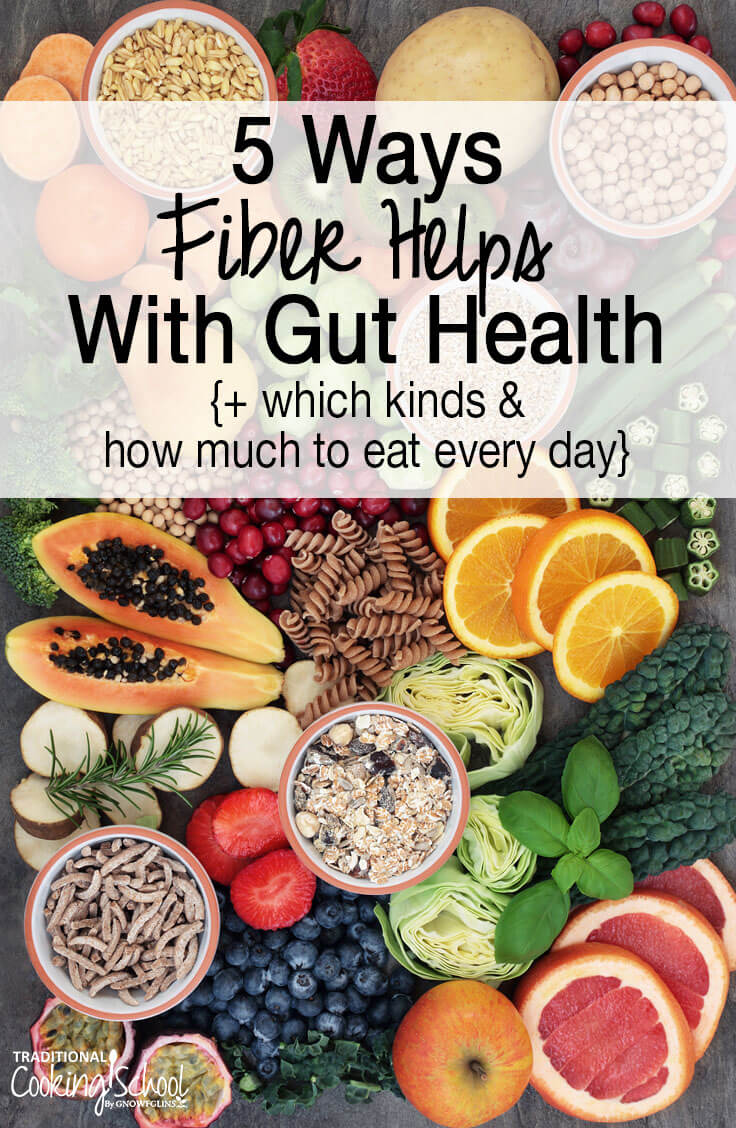
What is dietary fiber?
It’s one of the science-y things that gets complicated quickly, but you can think of it like this…
Fiber resides in plant cell walls to give plants their shape and structure. It’s mostly carbohydrate. So when we eat plant foods like vegetables and fruits, in addition to their vitamins, minerals, and antioxidants, we eat their fiber.
Once ingested, fiber resists the action of digestive enzymes, passing through the small intestine intact instead of being digested or absorbed. It then arrives in the large intestine, where resident microflora in the colon ferment it. The extent of fermentation depends on the type of fiber. Also in the intestines, depending on type, fiber absorbs toxins that our bodies are attempting to get rid of, helping them to leave the body rather than be recirculated.
You may have noticed: when we eat fiber, it doesn’t provide us with any energy! We don’t digest or absorb it. It doesn’t ever truly enter our bodies. So what good can it possibly do us?
As it turns out, an awful lot… Let’s dig in!
The Types Of Dietary Fiber
Fiber can be categorized based on its solubility, fermentability, and viscosity. Keep in mind there’s a good deal of overlap between these adjectives!
Soluble fibers, so named because they dissolve in water, are usually easily fermented by bacteria in the colon (although this isn’t true for all). Gases like hydrogen, vitamins, and short chain fatty acids (see below) are all by-products of their fermentation.
All soluble fibers are also viscous. Soluble fibers can be found in beans, lentils, oats, Brussels sprouts, root veggies and sweet potatoes, asparagus, citrus fruits, apples, broccoli, winter squash, and more (source).
Insoluble fibers, which don’t dissolve in water, include the well-known “resistant starches” found in green bananas, green plantains, cooked and cooled potatoes, and more (source). Some insoluble fibers are fermentable, while others aren’t. If fermented, insoluble fibers also produce gases, vitamins, and short chain fatty acids.
Insoluble fibers can be found in avocados, baked apples, soaked and dehydrated nuts, cooked carrots, cooked cauliflower, dried figs, berries, cooked spinach, cooked parsnips, and more (source).
Fermentable fibers are prebiotic, meaning that they feed probiotic bacteria. Most soluble fibers are fermentable, yet some insoluble are too.
Viscose fibers include all soluble fibers. Viscosity measures how thick a fiber gets when it is mixed with water and other substances in the digestive tract. Since soluble fiber is the type that dissolves in water, it makes sense that insoluble fibers can’t be viscous.
5 Ways Fiber Helps With Gut Health
Let’s quickly run through some of the many benefits of dietary fiber!
#1 — Fiber Busts Constipation
Soluble fibers ease constipation by absorbing water and carrying it to the colon, where it softens stool (source). By nature of being mostly fermentable, soluble fibers also bulk up stool by increasing bacterial mass. (The more food, the more bacteria!) The bacteria then also attract water.
Insoluble fibers also bulk up stool. Since they aren’t digested and many insoluble fibers aren’t fermented either, there’s not much else for them to do except take up space (source)!
As a general rule, the less fermentable the fiber, the more fecal bulk, and the greater the laxative effect. Furthermore, the larger a given stool, the faster its passage through the digestive tract, and thus less constipation.
Fiber also busts constipation by helping regulate peristalsis — the rhythmic contractions of the intestinal muscles that push food through the digestive tract.
However, keep in mind that consuming more fiber does not necessarily fix constipation. More fiber may be more constipating to certain people because it bulks up the stools too much. Finding the right amount of fiber for each individual is the best approach; and sometimes for people struggling with constipation or other digestive issues, reducing fiber may help them feel better.
#2 — Fiber Promotes A Healthy Gut
Fermentable fibers — whether soluble or insoluble — promote gut health by feeding good gut bacteria. In this way, they are prebiotic. The by-products of their fermentation include short chain fatty acids (butyrate, acetate, proprionate) which…
- provide energy to cells lining the digestive tract
- prevent “leaky gut” by maintaining gut wall integrity
- aid in mineral absorption, especially calcium, magnesium, copper, zinc, and iron
And so, by maintaining a healthy gut (one full of diverse, balanced, and resilient microflora), fiber helps modulate the immune system, balance hormones, and so much more (source).
Now, the extent to which fibers are fermented depends on the type of fiber, as we’ve seen, yet it also depends on each individual and their specific gut flora.
If your colon is a barren wasteland or full of bad bacteria, there’s not going to be a whole lot of beneficial fermentation going on (that’s why we should all eat probiotic foods, too)! Yet fermentable fibers can also help because many of them selectively feed only good bacteria.
#3 — Fiber Enhances Insulin Sensitivity
Our bodies depend upon glucose for energy, and so insulin — the hormone that ferries glucose into cells — is equally important. For insulin to be effective, cells must remain sensitive to it. For this to happen, glucose must trickle into the bloodstream from the digestive system in slow, yet steady amounts. Never too much, never too little.
And fiber helps, by slowing the digestion and absorption of nutrients in the small intestine as it passes through to the colon. Instead of a sudden deluge of glucose, the bloodstream receives only a little bit at a time. Success!
Learn more about insulin sensitivity here.
#4 — Fiber Eliminates Toxins
Insoluble and soluble fibers bind to toxins (and even excess hormones) in the digestive tract, thereby helping flush them out of the body. The importance of this can’t be overstated. Toxins — ranging from heavy metals to pesticides, herbicides, and industrial chemicals — wreak havoc on our bodies.
They accumulate in the thyroid to cause thyroid disease, suppress immunity, overtax our livers and kidneys, and in pregnant women, can even cross the placenta.
Did you know that the placenta actively pumps mercury into the fetal circulatory system so that by the end of pregnancy, cord levels may exceed that of the mother’s own blood (Having Faith: An Ecologist’s Journey to Motherhood, page 34)? Mercury is an incredibly destructive neurotoxin, especially to unborn babies.
So, too, excess hormones can contribute to hormone imbalance. Estrogen in particular, if not detoxed through the gut, returns to the bloodstream to create estrogen dominance (source).
All things considered, detoxification is very important!
#5 — Fiber Supports Satiety
The simple act of chewing fiber-rich foods promotes satiety! The more time you spend chewing, the more saliva and gastric acid your body produces. This increases gastric distension — in other words, how full the stomach is — which in turn triggers the vagus nerve to signal to the brain that you’re full. How neat is that? 🙂
The vagus nerve travels from brain to gut; think of it as the physical manifestation of the “gut-brain axis“!
Soluble and viscous fibers, thanks to their water-binding property, also increase gastric distension and thus satiety.
Insoluble fibers promote satiety too, by suppressing ghrelin (the hunger hormone). They also help the body recycle bile salts, and so support fat and fat-soluble vitamin digestion and absorption.
Fat is twice as calorie-dense than protein or carb, and so eating it tends to make one feel more full. Interestingly, soluble fibers merely bind to bile salts so they can be excreted.
Which Type Of Fiber Is Best?
As you can see, all types of fiber are beneficial — albeit in different ways.
Soluble fibers tend to be the most gentle and effective, especially for those struggling with digestive issues or chronic illness. Scientists also agree that whole food sources of fiber are better than any supplement. And since vegetables and fruits provide a mix of soluble, insoluble, fermentable, and viscous fibers — it’s almost too easy. Just eat your fruits and veggies! Beans and oats are terrific sources of fiber, as well, just be careful not to overdo, which we’ll discuss next.
How Much Fiber Should You Eat?
The RDA for women is about 25 grams per day, while men should aim for about 38 grams per day. The average American eats 8 grams of fiber per day. People speculate that traditional cultures ate between 40 to 100 grams of fiber every day!
100 grams is hard to achieve for even the most dedicated of us nowadays, in addition to potentially not being advisable for those with chronic illness, so simply aim to find the sweet spot where you are not making any issues (such as constipation, hormone imbalances, or fatigue) worse and might even be feeling better and going #2 better.
Most are likely to do best with soluble fiber due to its being more gentle. Experiment with different forms from beans, oats and other grains, to fruits and vegetables. What seems to do your body good, and what amount?
Experiment with different times of day. You do not have to have fiber with every meal, but you should have the right amount of fiber for you regularly, whether that’s once a day or with each meal.
Try not to change too many variables at once, so you can see what really seems to make a difference either way, and adjust accordingly.
And always remember, more fiber is not always the answer… even though that’s what conventional medicine tells us. No one should be reaching for an ideal number. Instead, try to find the sweet spot for your body to feel its best.
Individuals have different tolerance levels for fiber. Fermentation can cause uncomfortable gas or bloating, while the speed with which insoluble fibers travel through the GI tract can be abrasive and irritating. Be aware of your own body and adjust accordingly.
Do you make an effort to eat lots of fiber-rich foods?
Referenced throughout: Modern Nutrition in Health and Disease, 11th edition, pages 58-63; Paleo Principles, pages 39-46; 153-155.
...without giving up the foods you love or spending all day in the kitchen!

2 free books:
Eat God's Way
Ditch the Standard American Diet, get healthier & happier, and save money on groceries...
We only recommend products and services we wholeheartedly endorse. This post may contain special links through which we earn a small commission if you make a purchase (though your price is the same).


Hi Wardee,
Do you have a list of starchy and non-starchy vegetables?
I’m searching the Internet but I find different information all the time.
Thanks for your help!